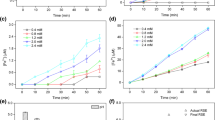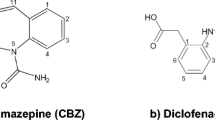Abstract
This study evaluates the performance of photoelectrocoagulation, peroxi-electrocoagulation, and peroxi-photoelectrocoagulation for the removal of the antiviral drug lamivudine formulation from wastewater by a stainless-steel electrode. To investigate matrix effects for this oxidation process, the influence of substrates such as urea and simulated wastewater (SWW) was studied. Moreover, degradation kinetics and energy efficiency are also discussed. Results indicate that the removal efficiency was in the order of peroxi-photoelectrocoagulation > peroxi-photoelectrocoagulation (in the presence of urea) > peroxi-photoelectrocoagulation (in the presence of SWW) > peroxi-electrocoagulation > photoelectrocoagulation. In peroxi-photoelectrocoagulation, the 96% degradation of lamivudine formulation indicates a nearly complete degradation of lamivudine. In this process, the presence of urea and SWW resulted in a substantial reduction of chemical oxygen demand (COD) decay. Kinetic studies using linear pseudo-first and pseudo-second-order reaction kinetics showed that the pseudo-first-order equation effectively described the removal of lamivudine formulation. The highest energy consumption per kgCOD decay (i.e., kWh kgCOD− 1) was obtained for the photoelectrocoagulation process, while the lowest energy consumption was obtained for peroxi-electrocoagulation, for all electrolysis times. The peroxi-photoelectrocoagulation process was shown to be an effective and energy-efficient technique for removing the antiviral drug lamivudine formulation from wastewater.
Graphic abstract








Similar content being viewed by others
References
Kim K-R, Owens G, Kwon S-I et al (2011) Occurrence and Environmental Fate of Veterinary Antibiotics in the Terrestrial Environment. Water Air Soil Pollut 214:163–174
Li X, Xie Y, Wang J et al (2013) Influence of planting patterns on fluoroquinolone residues in the soil of an intensive vegetable cultivation area in northern China. Sci Total Environ 458–460:63–69
Na G, Fang X, Cai Y et al (2013) Occurrence, distribution, and bioaccumulation of antibiotics in coastal environment of Dalian, China. Mar Pollut Bull 69:233–237
Li W, Shi Y, Gao L et al (2012) Occurrence of antibiotics in water, sediments, aquatic plants, and animals from Baiyangdian Lake in North China. Chemosphere 89:1307–1315
Fekadu S, Alemayehu E, Dewil R, Van der Bruggen B (2019) Pharmaceuticals in freshwater aquatic environments: A comparison of the African and European challenge. Sci Total Environ 654:324–337
Rizzo L, Manaia C, Merlin C et al (2013) Urban wastewater treatment plants as hotspots for antibiotic resistant bacteria and genes spread into the environment: A review. Sci Total Environ 447:345–360
Sui Q, Zhao W, Cao X et al (2017) Pharmaceuticals and personal care products in the leachates from a typical landfill reservoir of municipal solid waste in Shanghai, China: Occurrence and removal by a full-scale membrane bioreactor. J Hazard Mater 323:99–108
Peltzer PM, Lajmanovich RC, Attademo AM et al (2017) Ecotoxicity of veterinary enrofloxacin and ciprofloxacin antibiotics on anuran amphibian larvae. Environ Toxicol Pharmacol 51:114–123
Saravanan M, Hur JH, Arul N, Ramesh M (2014) Toxicological effects of clofibric acid and diclofenac on plasma thyroid hormones of an Indian major carp, Cirrhinus mrigala during short and long-term exposures. Environ Toxicol Pharmacol 38:948–958
Schultz MM, Painter MM, Bartell SE et al (2011) Selective uptake and biological consequences of environmentally relevant antidepressant pharmaceutical exposures on male fathead minnows. Aquat Toxicol 104:38–47
Contardo-Jara V, Lorenz C, Pflugmacher S et al (2011) Exposure to human pharmaceuticals Carbamazepine, Ibuprofen and Bezafibrate causes molecular effects in Dreissena polymorpha. Aquat Toxicol 105:428–437
Strauch S, Jantratid E, Dressman JB et al (2011) Biowaiver monographs for immediate release solid oral dosage forms: Lamivudine. J Pharm Sci 100:2054–2063
K’oreje KO, Vergeynst L, Ombaka D et al (2016) Occurrence patterns of pharmaceutical residues in wastewater, surface water and groundwater of Nairobi and Kisumu city. Kenya Chemosphere 149:238–244
Johnson MA, Moore KHP, Yuen GJ et al (1999) Clinical pharmacokinetics of lamivudine. Clin Pharmacokinet 36:41–66
Vaňková M (2010) Biodegradability analysis of pharmaceuticals used in developing countries; screening with OxiTop ® - C 110
Bedse G, Kumar V, Singh S (2009) Study of forced decomposition behavior of lamivudine using LC, LC-MS/TOF and MSn. J Pharm Biomed Anal 49:55–63
Kanakaraju D, Glass BD, Oelgem M (2018) Advanced oxidation process-mediated removal of pharmaceuticals from water: A review. J Environ Manage 219:189–207
Papastefanakis N, Mantzavinos D, Katsaounis A (2010) DSA electrochemical treatment of olive mill wastewater on Ti/RuO 2 anode. J Appl Electrochem 40:729–737
Boye B, Farnia G, Sandonà G et al (2005) Removal of vegetal tannins from wastewater by electroprecipitation combinedwith electrogenerated Fenton oxidation. J Appl Electrochem 35:369–374
Krishna BM, Murthy UN, Manoj Kumar B, Lokesh KS (2010) Electrochemical pretreatment of distillery wastewater using aluminum electrode. J Appl Electrochem 40:663–673
Tirado L, Gökkuş Ö, Brillas E, Sirés I (2018) Treatment of cheese whey wastewater by combined electrochemical processes. J Appl Electrochem 48:1307–1319
Farhadi S, Aminzadeh B, Torabian A et al (2012) Comparison of COD removal from pharmaceutical wastewater by electrocoagulation, photoelectrocoagulation, peroxi-electrocoagulation and peroxi-photoelectrocoagulation processes. J Hazard Mater 219–220:35–42
Brillas E, Sirés I, Oturan MA (2009) Electro-Fenton Process and Related Electrochemical Technologies Based on Fenton’s Reaction Chemistry. Chem Rev 109:6570–6631
Puspita P, Roddick F, Porter N (2015) Efficiency of sequential ozone and UV-based treatments for the treatment of secondary effluent. Chem Eng J 268:337–347
Katsoyiannis IA, Canonica S, von Gunten U (2011) Efficiency and energy requirements for the transformation of organic micropollutants by ozone, O3/H2O2 and UV/H2O2. Water Res 45:3811–3822
Vilhunen S, Vilve M, Vepsäläinen M, Sillanpää M (2010) Removal of organic matter from a variety of water matrices by UV photolysis and UV/H2O2 method. J Hazard Mater 179:776–782
Moreno CHA, Cocke DL, Gomes JAG et al (2009) Electrochemical Reactions for Electrocoagulation Using Iron Electrodes. Ind Eng Chem Res 48:2275–2282
An T, An J, Yang H et al (2011) Photocatalytic degradation kinetics and mechanism of antivirus drug-lamivudine in TiO2 dispersion. J Hazard Mater 197:229–236
Loos G, Scheers T, Van Eyck K et al (2018) Electrochemical oxidation of key pharmaceuticals using a boron doped diamond electrode. Sep Purif Technol 195:184–191
Jiang J, Graham N, André C et al (2002) Laboratory study of electro-coagulation–flotation for water treatment. Water Res 36:4064–4078
Pablo Cañizares C, Jiménez F, Martínez, et al (2007) Study of the Electrocoagulation. Process Using Aluminum and Iron Electrodes. https://doi.org/10.1021/IE070059F
Parga JR, Cocke DL, Valverde V et al (2005) Characterization of Electrocoagulation for Removal of Chromium and Arsenic. Chem Eng Technol 28:605–612
Bazrafshan E, Mohammadi L, Ansari-Moghaddam A, Mahvi AH (2015) Heavy metals removal from aqueous environments by electrocoagulation process– a systematic review. J Environ Heal Sci Eng 13:74
Holt PK, Barton GW, Mitchell CA (2005) The future for electrocoagulation as a localised water treatment technology. Chemosphere 59:355–367
Boczkaj G, Fernandes A (2017) Wastewater treatment by means of advanced oxidation processes at basic pH conditions: A review. Chem Eng J 320:608–633
Gargurevich IA (2016) Aqueous Urea Decomposition Reactor: Reaction Modeling and Scale Up. J Chem Eng Process Technol 07:2–5
Rusydi AF (2018) Correlation between conductivity and total dissolved solid in various type of water: A review. IOP Conf Ser Earth Environ Sci 118:012019
Ali NS, Mo K, Kim M (2012) A case study on the relationship between conductivity and dissolved solids to evaluate the potential for reuse of reclaimed industrial wastewater. KSCE J Civ Eng. https://doi.org/10.1007/s12205-012-1581-x
Sahu JN, Gangadharan P, Patwardhan AV, Meikap BC (2009) Catalytic hydrolysis of urea with fly ash for generation of ammonia in a batch reactor for flue gas conditioning and NOx reduction. Ind Eng Chem Res 48:727–734
Li L, Zhang S, Li G, Zhao H (2012) Determination of chemical oxygen demand of nitrogenous organic compounds in wastewater using synergetic photoelectrocatalytic oxidation effect at TiO2 nanostructured electrode. Anal Chim Acta 754:47–53
Urbańczyk E, Sowa M, Simka W (2016) Urea removal from aqueous solutions—a review. J Appl Electrochem 46:1011–1029
Al-Shannag M, Al-Qodah Z, Bani-Melhem K et al (2015) Heavy metal ions removal from metal plating wastewater using electrocoagulation: Kinetic study and process performance. Chem Eng J 260:749–756
Zhang X, Lin H, Hu B (2016) Phosphorus removal and recovery from dairy manure by electrocoagulation. RSC Adv 6:57960–57968
Gurung K, Ncibi MC, Shestakova M, Sillanpää M (2018) Removal of carbamazepine from MBR effluent by electrochemical oxidation (EO) using a Ti/Ta2O5-SnO2 electrode. Appl Catal B Environ 221:329–338
Bucchianico AD (2014) Coefficient of Determination (R 2). Wiley StatsRef Stat Ref Online 2
Jarrah N, Mu’azu ND (2016) Simultaneous electro-oxidation of phenol, CN–, S2 – and NH4 + in synthetic wastewater using boron doped diamond anode. J Environ Chem Eng 4:2656–2664
Bolton JR, Bircher KG, Tumas W, Tolman CA (2001) Figures-of-merit for the technical development and application of advanced oxidation technologies for both electric-and solar-driven systems (IUPAC Technical Report). Pure Appl Chem 73:1998–1999
Acknowledgements
The first author would like to thank NASCERE scholarship program and Jimma University for financial support.
Author information
Authors and Affiliations
Corresponding author
Additional information
Publisher's Note
Springer Nature remains neutral with regard to jurisdictional claims in published maps and institutional affiliations.
Rights and permissions
About this article
Cite this article
Fekadu, S., Alemayehu, E., Dewil, R. et al. Electrochemical degradation of antivirus drug lamivudine formulation: photoelectrocoagulation, peroxi-electrocoagulation, and peroxi-photoelectrocoagulation processes. J Appl Electrochem 51, 607–618 (2021). https://doi.org/10.1007/s10800-020-01521-1
Received:
Revised:
Accepted:
Published:
Issue Date:
DOI: https://doi.org/10.1007/s10800-020-01521-1




